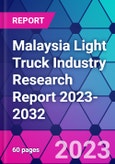The trade dynamics of commercial vehicles in Malaysia mirror those of passenger cars. The country has been grappling with a trade deficit in the import and export of commercial vehicles. However, compared to passenger vehicles, the volume of commercial vehicle imports in Malaysia is significantly smaller due to the limited size of the domestic market and negligible commercial vehicle exports. The primary export destinations for Malaysian commercial vehicles include Indonesia, Thailand, and Papua New Guinea. Exports to Indonesia and Thailand have exhibited fluctuations from year to year, while exports to Papua New Guinea have shown a consistent upward trend.
Since 2015, there has been a noticeable shift in consumer preference in Malaysia from C-segment vehicles to pickup trucks. This shift can be attributed to the diverse features offered by pickup trucks, an increase in the number of entrepreneurs in this segment, and the availability of affordable pickup truck models. Numerous Original Equipment Manufacturers (OEMs) have capitalized on this trend by offering multiple variants and retrofitted models. The reliability and high resale value of pickup trucks have further fueled the growing demand in Malaysia.
From 2018 to 2022, as analyzed, the sales of light commercial vehicles in Malaysia displayed a fluctuating pattern, initially decreasing and then increasing, with a Compound Annual Growth Rate (CAGR) of 17.45% from 2019 to 2022. The Covid-19 pandemic led to a 5.09% decline in annual light commercial vehicle sales in Malaysia in 2020, with a total of 37,000 units sold. Subsequently, with the gradual easing of restrictions and the recovery of the economy and supply chain, Malaysia's light commercial vehicle market began to rebound in 2021 and 2022. During these years, annual sales of light commercial vehicles increased by 20.14% and 42.08%, respectively, with sales figures reaching 44,000 units and 63,000 units.
Boasting an impressive 89% Internet penetration rate, Malaysia ranks among the top Southeast Asian nations for Internet usage. The country's e-commerce market is experiencing rapid growth, surpassing mature markets in the region. In 2022 alone, the Malaysian e-commerce market is expected to grow by 20%. This growth aligns with a rising consumer preference for online shopping and the availability of customized payment options. Projections indicate that by 2027, Malaysia's e-commerce market will reach $16.98 billion, growing at a CAGR of 13.6%. The robust expansion of the e-commerce sector has spurred increased demand for logistics and courier services in Malaysia, contributing to the growing need for light trucks.
The analysis anticipates that Malaysia's annual light truck sales will reach 145,000 units by 2032, experiencing a compound annual growth rate (CAGR) of 8.7% during the 2023-2032 period.
Topics covered:
- Overview of the Light Truck Industry in Malaysia
- Economic and Policy Environment of Light Truck Industry in Malaysia
- What is the impact of COVID-19 on the light truck industry in Malaysia?
- Malaysia Light Truck Industry Market Size, 2023-2032
- Analysis of Major Malaysian Light Truck Industry Players
- Key Drivers and Market Opportunities for Light Truck Industry in Malaysia
- What are the key drivers, challenges and opportunities for the Light Truck industry in Malaysia during the forecast period 2023-2032?
- Which are the key players in the Malaysia Light Truck Industry market and what are their competitive advantages?
- What is the expected revenue of Malaysia Light Truck Industry market during the forecast period 2023-2032?
- What are the strategies adopted by the key players in the market to increase their market share in the industry?
- Which segment of the Malaysia light truck industry market is expected to dominate the market by 2032?
- What are the major unfavorable factors faced by the Light Trucks industry in Malaysia?
Table of Contents
Companies Mentioned
- Daihatsu
- Proton
- Perodua
- Hino
- Mitsubishi
- Toyota
- Isuzu
- Ford
Methodology
Background research defines the range of products and industries, which proposes the key points of the research. Proper classification will help clients understand the industry and products in the report.
Secondhand material research is a necessary way to push the project into fast progress. The analyst always chooses the data source carefully. Most secondhand data they quote is sourced from an authority in a specific industry or public data source from governments, industrial associations, etc. For some new or niche fields, they also "double-check" data sources and logics before they show them to clients.
Primary research is the key to solve questions, which largely influence the research outputs. The analyst may use methods like mathematics, logical reasoning, scenario thinking, to confirm key data and make the data credible.
The data model is an important analysis method. Calculating through data models with different factors weights can guarantee the outputs objective.
The analyst optimizes the following methods and steps in executing research projects and also forms many special information gathering and processing methods.
1. Analyze the life cycle of the industry to understand the development phase and space.
2. Grasp the key indexes evaluating the market to position clients in the market and formulate development plans
3. Economic, political, social and cultural factors
4. Competitors like a mirror that reflects the overall market and also market differences.
5. Inside and outside the industry, upstream and downstream of the industry chain, show inner competitions
6. Proper estimation of the future is good guidance for strategic planning.

LOADING...








